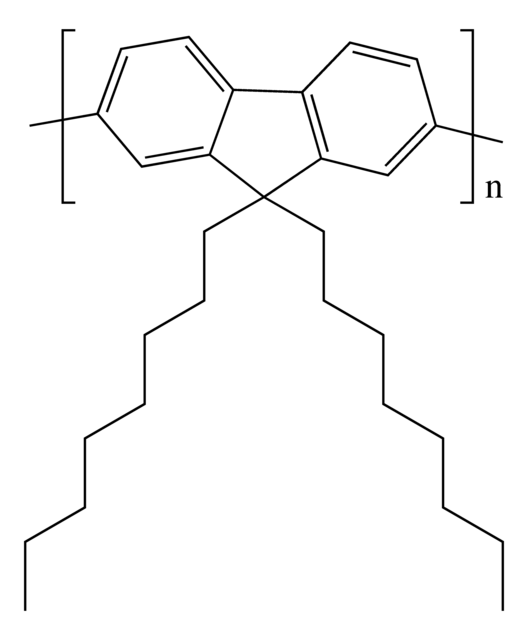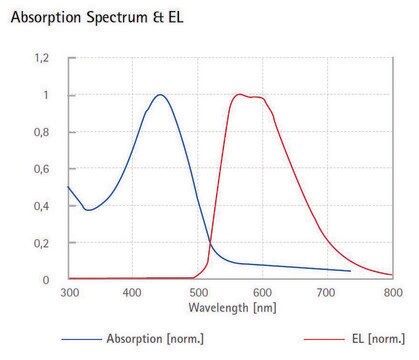571652
Poly(9,9-di-n-octylfluorenyl-2,7-diyl)
light-emitting polymer
Sinónimos:
Fluorenyl polymer
About This Item
Productos recomendados
Nivel de calidad
formulario
solid
mol peso
Mw ≥20000
solubilidad
chloroform: soluble
λmáx.
365 nm
fluorescencia
λex 374 nm; λem 417 nm in chloroform(lit.)
rendimiento de la unidad OLED
ITO/PEDOT:PSS/PVK/PFO/Ca
ITO/PEDOT:PSS/PVK/PFO:Ir(btpy)3 (5 wt%)/Ca
ITO/PEDOT:PSS/PVK/PFO:Iridium (III) tris(2-(4-tolyl)pyridinato-N,C2) (5 wt%)/Ca
Mw/Mn
~3.7
¿Está buscando productos similares? Visita Guía de comparación de productos
Descripción general
Aplicación
Código de clase de almacenamiento
11 - Combustible Solids
Clase de riesgo para el agua (WGK)
WGK 3
Punto de inflamabilidad (°F)
Not applicable
Punto de inflamabilidad (°C)
Not applicable
Equipo de protección personal
Eyeshields, Gloves, type N95 (US)
Elija entre una de las versiones más recientes:
¿Ya tiene este producto?
Encuentre la documentación para los productos que ha comprado recientemente en la Biblioteca de documentos.
Artículos
Light-Emitting Polymers
Single-walled carbon nanotubes (SWCNTs) are promising materials for use in the active channel of field-effect transistors (FETs), photoabsorbing layers of solar cells and photodetectors because of their ultrafast charge transport mobility.
Dr. Tan and researcher introduce recent trends in Self-healing Soft Electronic Materials and Devices. The emergence of smart, functional SHPs will be highly beneficial to the advancement of the next-generation self-healing soft electronic devices. Autonomously self-healing devices could help to minimize the need for repair or replacement of electronics and machines, potentially reducing the cost of materials and reducing electronic waste.
Nuestro equipo de científicos tiene experiencia en todas las áreas de investigación: Ciencias de la vida, Ciencia de los materiales, Síntesis química, Cromatografía, Analítica y muchas otras.
Póngase en contacto con el Servicio técnico![Poly[(9,9-di-n-octylfluorenyl-2,7-diyl)-alt-(benzo[2,1,3]thiadiazol-4,8-diyl)] average Mn ≤25000](/deepweb/assets/sigmaaldrich/product/structures/428/661/1c4ebb98-9d51-48c0-96c7-e556ca425aa4/640/1c4ebb98-9d51-48c0-96c7-e556ca425aa4.png)
![Poly[9,9-bis-(2-ethylhexyl)-9H-fluorene-2,7-diyl] light-emitting λem 409 nm (in chloroform)](/deepweb/assets/sigmaaldrich/product/structures/186/919/a69a261c-1d02-44b4-82ab-119ad6c9d843/640/a69a261c-1d02-44b4-82ab-119ad6c9d843.png)

![Poly[2-methoxy-5-(2-ethylhexyloxy)-1,4-phenylenevinylene] average Mn 40,000-70,000](/deepweb/assets/sigmaaldrich/product/structures/344/488/b8f8179d-3970-4deb-a754-adda88cdb36f/640/b8f8179d-3970-4deb-a754-adda88cdb36f.png)



![Poly[(9,9-dioctylfluorenyl-2,7-diyl)-co-bithiophene] 99.9%](/deepweb/assets/sigmaaldrich/product/structures/309/000/8b4a3f54-7765-4aca-96c4-74ce328d455d/640/8b4a3f54-7765-4aca-96c4-74ce328d455d.png)
